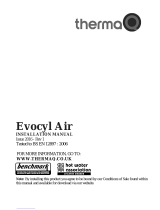
16
The following extract is taken from the latest G3 Regulations
Discharge pipes from safety devices
Discharge pipe D1
3.50 Safety devices such as
temperature relief valves or combined temperature and pressure and pressure relief valves (see
paragraphs 3.13 or 3.18) should discharge either directly or by way of a manifold via a short length of metal pipe (D1) to a tundish.
3.51 The diameter of discharge pipe (D1) should be not less than the nominal outlet size of the
temperature relief valve.
3.52 Where a manifold is used it should be sized to accept and discharge the total discharge form the discharge pipes connected to it.
3.53 Where valves other than the
temperature and pressure relief valve from a single unvented hot water system discharge by way of the
same manifold that is used by the safety devices, the manifold should be factory fitted as part of the hot water storage system unit or
package.
tundish should be vertical, located in the same space as the unvented hot water storage system and be fitted as close as possible
to, and lower than, the valve, with no more than 600mm of pipe between the valve outlet and the tundish
(see Diagram 1).
To comply with the Water Supply (Water Fittings) Regulations, the tundish should incorporate a suitable air gap.
3.55 Any discharge should be visible at the
tundish. In addition, where discharges from safety devices may not be apparent, e.g. in dwellings
occupied by people with impaired vision or mobility, consideration should be given to the installation of a suitable safety device to warn
when discharge takes place, e.g. electronically operated.
Discharge pipe D2
3.56 The discharge pipe (D2) from the
tundish should:
(a) have a vertical section of pipe at least 300mm long below the tundish before any elbows or bends in the pipework
(see Diagram 1); and
(b) be installed with a continuous fall thereafter of at least 1 in 200.
3.57 The discharge pipe (D2) should be made of:
(a) metal; or
(b) other material that has been demonstrated to be capable of safely withstanding temperatures of the water discharged
and is clearly and permanently marked to identify the product and performance standard (e.g. as specified in the
relevant part of BS 7291).
3.58 The discharge pipe (D2) should be at least one pipe size larger than the nominal outlet size of the safety device unless its total equivalent
hydraulic resistance exceeds that of a straight pipe 9m long, i.e. for discharge pipes between 9m and 18m the equivalent resistance
length should be at least two sizes larger than the nominal outlet size of the safety device; between 18 and 27m at least 3 sizes larger,
and so on; bends must be taken into account in calculating the flow resistance.
See Diagram 1, Table 1 and the worked example.
An alternative approach for sizing discharge pipes would be to follow Annex D, section D.2 of BS 6700:2006 Specification
for design, installation, testing and maintenance of services supplying water for domestic use within buildings and their
curtilages.
3.59 Where a single common discharge pipe serves more than one system, it should be at least one pipe size larger than the largest individual
discharge pipe (D2) to be connected.
3.60 The discharge pipe should not be connected to a soil discharge stack unless it can be demonstrated that that the soil discharge stack is
capable of safely withstanding temperatures of the water discharged, in which case, it should:
(a) contain a mechanical seal, not incorporating a water trap, which allows water into the branch pipe without allowing
foul air from the drain to be ventilated through the tundish;
(b) be a separate branch pipe with no sanitary appliances connected to it;
(c) if plastic pipes are used as branch pipes carrying discharge from a safety device they should be either polybutalene
(PB) to Class S of BS 7291-2:2006 or cross linked polyethylene (PE-X) to Class S of BS 7291-3:2006; and
( d) be continuously marked with a warning that no sanitary appliances should be connected to the pipe.
1. Plastic pipes should be joined and assembled with fittings appropriate to the circumstances in which they are used as set out in
BS EN ISO 1043-1.
2. Where pipes cannot be connected to the stack it may be possible to route a dedicated pipe alongside or in close proximity to the
discharge stack.
Termination of discharge pipe
3.61 The discharge pipe (D2) from the
tundish should terminate in a safe place where there is no risk to persons in the vicinity of the
discharge.
3.62 Examples of acceptable discharge arrangements are:
b) to a trapped gully with the end of the pipe below a fixed grating and above the water seal;
(c) downward discharges at low level; i.e. up to 100mm above external surfaces such as car parks, hard standings,
grassed areas etc. are acceptable providing that a wire cage or similar guard is positioned to prevent contact,
whilst maintaining visibility; and
(d) discharges at high level: e.g. into a metal hopper and metal downpipe with the end of the discharge pipe clearly
visible or onto a roof capable of withstanding high temperature discharges of water and 3m from any plastic
guttering system that would collect such discharges.
3.63 The discharge would consist of high temperature water and steam. Asphalt, roofing felt and non-metallic rainwater goods may be
damaged by such discharges.























